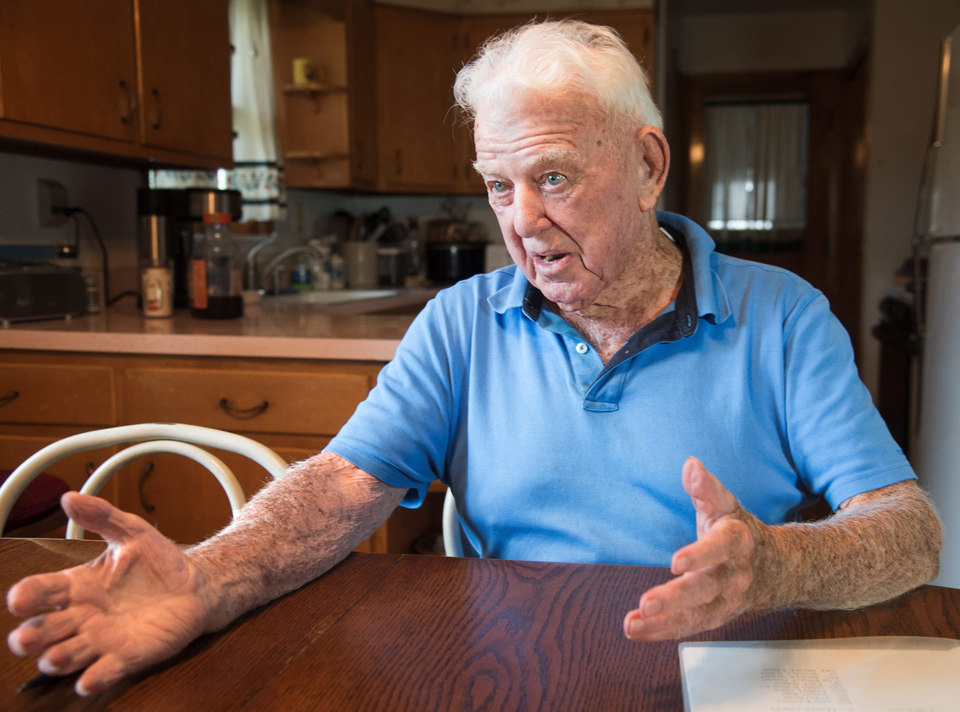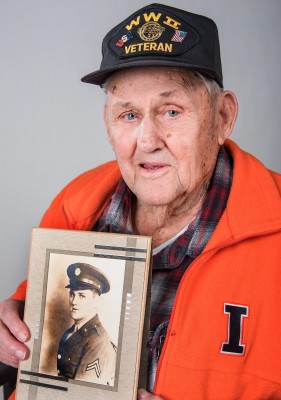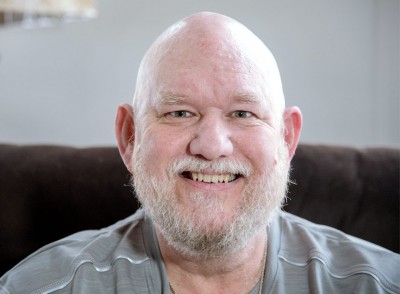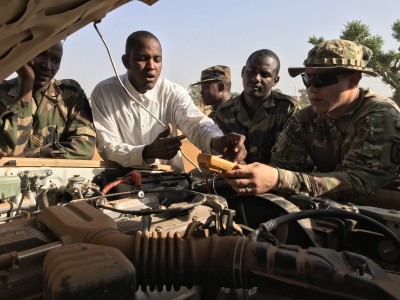Les Gadbury
By Paul Wood

Photo By Robin Scholz/The News-Gazette
MONTICELLO — It has been 72 years since Marine Cpl. Les Gadbury fought his way across Iwo Jima, and he still remembers the names of the men who fell to Japanese fire.
But as he tells the story of a friend who fell on top of him, and said, “Gadbury, I’m dying,” his eyes start to tear up.
“I’m sorry,” he says. “That hasn’t happened before.”
At 94, the man who fought in Bougainville, Guam, and most intensely on Iwo Jima is sorry because he got emotional. That he let the story of friends hit by mortar fire, small arms fire and even anti-aircraft shells finally wear him down.
This after talking about being blasted “senseless” into the air and landing on his feet at Iwo Jima, or a small shrapnel wound on Guam. He never got a Purple Heart.
After two years in the South Pacific fighting Japanese soldiers desperate to protect their homelands, the Marines were supposed to be rotated out, but Gadbury’s squad kept fighting on.
Gadbury grew up in Monticello and, like many, volunteered for his four years — in the Marines, the first to land on enemy-held islands along the chain to Japan.
After basic training, he spent almost all his time in the service as a member of “C” Company, 1st Battalion, of the newly organized 9th Marine Regiment as a machine gunner until April 23, 1945.
It started nice enough, two weeks on a large converted luxury liner, the USS Mt. Vernon, and on a zigzag, unescorted course to New Zealand.
Every island had its challenges, even before combat started.
On Guadalcanal, “during the nights, this had to be the worst place for mosquitoes one could ever find. Since this was a no-combat zone, we slept under mosquito nets. If your elbow or leg touched the net, the result was dozens of bites, immediately.”
In October 1943, he boarded the USS Crescent City, for Bougainville Island in the Solomon Islands.
The island had six airfields and an estimated 45,000 to 60,000 Japanese. He landed in the first wave.
“The sky was nearly blackened by so many airbursts,” he remembered.
“Shortly after landing and moving inland, artillery fire started falling on us. It wasn’t a heavy barrage, but well-spaced rounds were hitting our positions,” he wrote in a memoir. “No one had dug a foxhole yet, but things changed in a hurry. Everyone would be digging, a shell would hit and instantly no one could be seen as they were flattened on the ground. Then everyone was up instantly and digging in again.”
He saw his first dead Japanese soldier on top of a coconut tree. Thereafter, “we gave our undivided attention to these tree tops, for others also held live snipers.”
Moving inland, it was one skirmish after another. Disease and filth added to the danger.
“We were told that a few of us at a time could go to the rear and get clean clothing (dungarees) at a supply depot. The ones we were wearing at the time were the same dungarees we wore when boarding ship a month ago. Ours were now a mess and falling off of us,” he remembered.
Thanksgiving Day was a turkey dinner, but back to the front line the same day; Christmas Day came and went just like any other day. Finally, they were relieved.
In July 1944, his men landed on Guam.
“We were proud to take back an American possession after the Japanese took it,” he said.
Four days after the famous flag-raising on Iwo Jima, Gadbury was there.
He kept his head down in the foxhole when he could, but Japanese soldiers would appear out of tunnels or caves, and the bullets would fly.
The memories are horrifying. He said 56 of the 206 men in his company were killed.
“Out of our six machine gun squads, both the No. 1 and No. 2 gunners were killed in five of these squads during the battle. Several of these machine gunners were killed the first day, including Randall Hackenberg, who was my No. 1 gunner during the Guam campaign,” he recalled.
He never received a major medal and does not consider himself a hero.
“We were doing a job that had to be done,” he said.
After the war, he married Norma Gregory, of Moweaqua; both graduated from Illinois State University. They have five children. He’s retired after a long career as a teacher and coach in Atwood and Monticello.
Do you know a veteran who could share a story about military service? Contact staff writer Paul Wood at pwood@news-gazette.com.
Read more stories from local veterans:
 Robert Collins
FARMER CITY — Robert Collins served in Africa and invaded Sicily, then and southern France. He then had to fight his way …
Robert Collins
FARMER CITY — Robert Collins served in Africa and invaded Sicily, then and southern France. He then had to fight his way …
 Steve Stanley
URBANA — Staff Sgt. Steve Stanley had top-secret clearance, and was assigned to a secure area from which tactical nuclea …
Steve Stanley
URBANA — Staff Sgt. Steve Stanley had top-secret clearance, and was assigned to a secure area from which tactical nuclea …
 Seth Carroll
NIAMEY, NIGER — After serving in Bahrain and Turkey, Sgt. Seth Carroll has equipment stored and ready for any mission th …
Seth Carroll
NIAMEY, NIGER — After serving in Bahrain and Turkey, Sgt. Seth Carroll has equipment stored and ready for any mission th …